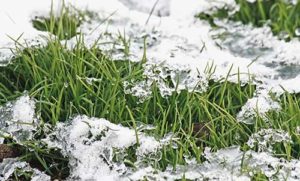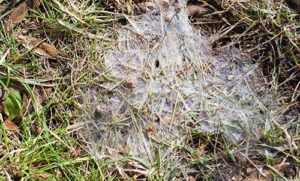How to Help Your Midwest Lawn Survive the Winter!
Snow is an inevitable part of winter in the midwest, and there are clear benefits and drawbacks of snow blanketing your lawn. To help ease your concerns about the adverse effects, and give credit to the advantages, let’s talk about how snow impacts your grass.
Snow Can Be Good for Your Lawn
Overall, the snow that falls during the winter has some advantageous effects on your lawn. It helps protect and nourish it, even though it seems innocuous to many of us.
- Snow acts as a vital insulator, protecting the delicate blades of grass and roots. When four or more inches blanket your yard, the snow helps hold heat underneath it, preventing the roots from freezing. Without this insulating layer, the frost line moves deeper beneath the soil surface, where it can damage the roots of young plantings. If you recently seeded your turf, a snow layer is beneficial to protect the newly developed roots.
- When the soil stays warm, both the earthworms and the beneficial soil microbes stay active, improving the soil structure, decomposing organic matter, and increasing the root uptake of nutrients and water.
- Snow also acts as a barrier against the harsh winter winds. A snow layer halts plant transpiration and closes stomatal openings, so the bitter drying winds pull less moisture from the grass blades.
- Nitrogen found in the snow is a nutrient that is essential for plant growth. As the flakes fall through the air, they collect atmospheric nitrogen that is delivered to the grass and soil once the snow melts. Heavier snow contains more trapped nitrogen than lighter snow. While it isn’t a significant amount, snow helps give up to five pounds of nitrogen across an acre.
- When temperatures rise and the snow melts, the moisture seeps down into the ground until it reaches the water table, where it ultimately collects for future use. Then, in the hot summer months or during a drought, the plant can use this reserve.
Snow Can Be Bad for Your Lawn
On the flip side, snow can also have negative impacts, especially if there is a heavy snowfall or too much snow piled in an area. The weight of heavy, wet snow may cause the grass’ crown to break, and the roots may die. It’s also critical to watch for pooling water and observe how it drains when the snow begins to melt. Ideally, you want the water to seep into the ground uniformly and not concentrate in one spot.
Using a snowblower on your lawn also poses problems. Heavy snow blowers can compact the soil under the tires if the ground isn’t frozen. If improperly used, augers can damage the grass, and the skid plate can gouge into the soil.
Ice Could Ruin Your Lawn

First and foremost, the sharp ice edges rip the grass blades, making them more susceptible to disease problems. But the more damaging aspect is when the grass is coated in ice, carbon dioxide builds up underneath the ice layer. In high enough concentrations, it becomes toxic to the plant and retards plant growth.
Dealing with ice and getting it melted off of your lawn also poses problems, especially if you opt to use ice melt chemical compounds. A big concern with ice melts is the chemical salts draw moisture from the grass, causing desiccation.
Other adverse effects depend on the ice melt formulation and ingredients.
Many products are formulated using chloride, which has significant disadvantages. While chloride is essential for plant growth, too much causes necrosis of the blade margins and tips. Chloride is also dangerous to pets and corrodes concrete and metals.
- Calcium chloride is popular because it gives off heat as it works, melting ice quicker. However, it does cause slight corrosion and is dangerous to pets and plants at high levels. If calcium levels get too high in the plant, it can stunt growth.
- Sodium chloride or rock salt is a common de-icer, but a buildup of sodium ions within the plant can cause toxicities that stunt plant growth and stop cellular development.
- Potassium chloride is similar to potassium-based fertilizers, so it doesn’t pose too many concerns to plants. However, it does have the typical chloride dangers and is dangerous to pets with renal problems.
- Magnesium chloride is effective at low temperatures and is less corrosive than some chloride formulations, but it is harmful to pets, children, and adults.
- Urea is an effective de-icer that is safe for pets and less corrosive than chloride-containing products. One concern is that its high nitrogen content can cause problems if runoff enters a water supply.
- Calcium magnesium (in calcium magnesium acetate) is less corrosive to concrete than other ice melts and has low toxicity to plants and animals but leaves a residue.
When using ice melt compounds, always check the formulation and use it sparingly to minimize the harmful side effects.
Snow Mold Is a Real Thing

Snow mold appears as gray and pink spots on your grass with a cobweb-like goo that turns into dead, bleached, or matted patches of grass. The pink areas are caused by Microdochium nivale, also called Microdochium patch or Fusarium patch; the gray mold is from Typhula incarnata, also called Typhula blight. Pink snow mold is more severe than gray—it kills the crown and roots, while gray snow mold only affects the blades.
Unfortunately, no fungicides work on snow mold once the snow melts in the spring. The best prevention is to aerate your lawn in the fall to open up the soil and improve drainage, remove any leaves and lawn debris before the snow falls, and apply a winterizing fertilizer.
Does Snow Hurt Grass Seed?

Winter Lawn Care Service From the Pros
Hire a professional lawn care company to take care of your winter lawn care needs, and save yourself some time. Ryan Lawn & Tree has over 35 years of experience in lawn maintenance and offers our services throughout every season. Contact us today to find out more about our services and how we can help your lawn to thrive.









